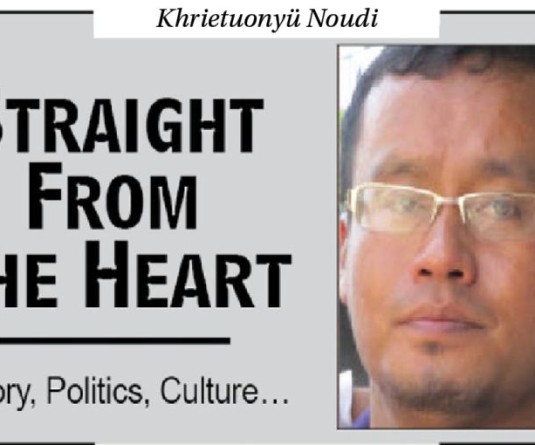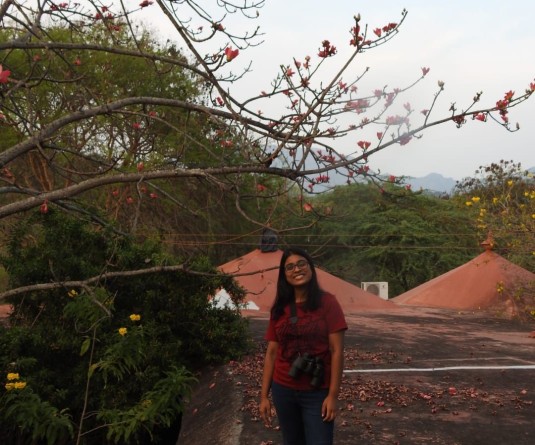
Temjenwapang Imsong
Unity College, Dimapur
Nestled in the heart of Medziphema, I had the privilege of visiting Healing Garden, as part of a ‘One day Field Trip’ organized by our Department on March 1, 2025. A serene garden, created and owned by the Naga historian and peace activist Dr. Visier M. Sanyü. As I stepped through the gate I was immediately enveloped in a sense of tranquility surrounded by nature’s splendor. The field trip was an unforgettable experience that not only educated us about the different dynamics associated with the garden but also left us feeling refreshed and rejuvenated.
Located on the outskirts, of Medziphema, Healing Garden is specifically designed to promote a sense of well-being and to help people gain a sense of healing by connecting with nature. During the interview session, Dr. Sanyü shared that his painful experiences, of Nagaland’s violent history of conflict, played a crucial role in his self-envisioning and creation of a space devoted to peace, tranquility, and healing. He clarified that he was not a member of any nationalist movement but that he was a product of the movement, and his role in brokering peace within Nagaland impacted the idea of the garden as a symbol of peace.
Expressing the desire to return home from Australia, after leaving Nagaland for decades during the Indo-Naga conflicts, Dr. Sanyü longed to give back something to his people. His main vision for the Healing Garden was, thus, to ensure a place for people to stay and be at peace and unity.
The garden plays an important role in sustaining local biodiversity as well, Dr Sanyü promotes and hopes that Healing Garden be home to native vegetation especially trees even in the years to come. The garden also signifies the interconnectedness that human beings share with nature. By keeping the garden original and not destroying its natural vegetation and landscape, environmental conservation and sustainability are achieved. The garden plays a huge role in conserving natural species- both flora and fauna, as native plants and animals are fast losing their homes due to developmental activities and urbanization. Based on the garden’s current situation, I am convinced that the trees which are mature and native, will stay healthy and emerge as a forest, helping the people as well as the animals and be a space for coexisting between nature and human beings.
The land covers roughly about 12 acres and the forest itself cover 3 acres. The garden is also based on cultural ideas to foster connectivity between people of different indigenous tribes- serving as a community space bringing people together for events, activities, or even recreation. According to Dr. Sanyü some come to use the garden as a place for functions, outings, and even weddings. Various institutions, churches, and clan had visited the garden like so. Besides these, the garden organizes peace education and workshops on self-healing.
The architecture and aesthetics of the Healing Garden are mostly based on Dr. Sanyü’s imagination and vision influenced by Naga traditional styles- for example, the seating area, an encirclement of stones is reflective of the Angami style of Morung seating area. His house with the traditional Naga style of elongated roofs was done by a Naga architecture, who helped him redesign and renovate his house. While the house is very modern and appears western-influenced, there is an unmistakable presence of Naga aesthetics in its designs and Naga architecture in its set ups.
There is very low maintenance in the Healing Garden as Dr. Sanyü preferred to keep it as natural as possible to maintain the authenticity. The maintenance of the garden was done through his life pension. He admitted, he was ‘outdated in terms of sponsorships but in future he would consider the option to collaborate with other organization if there is no harm to him or the garden.’
The visit to the garden has made me realise some vital aspects of our history and how it must have impacted our older generations. I have come to understand the functionality of blending our cultural heritage to contemporary lifestyles which can both be sustainable, relevant, and which need not compromise our identity. At the same time, I have better grasped the value of sustaining our native species- of flora and fauna for a healthier ecosystem.
In conclusion, the visit to the Healing Garden can provide one not only a deeper understanding of the connection between nature and wellness, but also provide one with a much-needed break from the tensions of everyday life.





